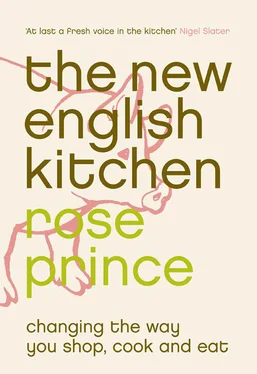I include these because they were one of the first things I ever made myself, and because my mother often made them for tea to eat with golden syrup and butter. The ingredients are pure store cupboard, so you won’t have to rush out and buy biscuits on a Sunday when someone drops in for tea. The recipe is from a much-Sellotaped 1950s copy of The Constance Spry Cookery Book – one of my bibles.
Makes about 12
240g/8oz plain flour
1/ 2teaspoon bicarbonate of soda
1/ 2teaspoon cream of tartar
1/ 2teaspoon baking powder
1 tablespoon golden caster sugar
a nut of butter
1 tablespoon golden syrup
about 300ml/ 1/ 2pint milk
1 egg
Mix the dry ingredients in a bowl, then rub in the butter and add the syrup. Add half the milk, mixing well with a wooden spoon. Break in the egg and beat well, then add the remaining milk. The mixture should just drop from the spoon. Allow to stand for 10–15 minutes, not more.
Heat an oiled flat griddle or heavy-based frying pan. When it is moderately hot, drop in the mixture in spoonfuls and cook for 2–3 minutes, until small bubbles appear on the surface. Flip the drop scones over and cook for about 30 seconds to brown the other side. Wrap the scones in a tea towel to keep them warm while you cook the rest, then serve with butter, jam and syrup.
It won’t be necessary to re-grease the pan as you cook each batch; the drop scones are all the better for being cooked without much oil at all.
The earliest breads were unleavened – they did not contain yeast. They were rolled or pressed out and baked absolutely flat. The offspring of these ancient flat breads can still be found in the Middle East, where there are hundreds of versions, including breads no thicker than card but floppy enough to wrap around herbs and salty cheese, and slightly thicker, round flat breads, which are put to use as a jacket for kebabs. I remember when pitta bread was considered avant garde, but now flat breads in every guise can be bought from Middle Eastern and Asian shops; even supermarkets sell several versions of flat bread, or ‘wraps’ – a word that came from the United States. There are soft breads such as Indian naan and chapatis or Mexican tortillas, crisp breads like lavash to crumble into soups and salads, or flaky roti to parcel up West Indian curries.
Making flat breads at home is good economics: a batch of up to ten can be made from 360g of good flour, worth less than 50 pence, which comes in at approximately a third of the cost of ten tortilla wraps or pitta breads.
I cannot even begin to give an authentic recipe for every kind of flat bread but the recipe below, adapted from Tom Jaine’s Making Bread at Home (Weidenfeld & Nicolson, 1995), makes a good, crisp, flat bread that can be broken into soup or a leafy salad, or used to scoop food into your mouth. It uses yeast, but you could use a little dough left over from the previous baking instead for the same lightening effect.
The secret of all flat breads is to rest the dough in the fridge. This gives the gluten time to relax, so that you can roll or press the bread out very flat. It also sours the dough slightly, adding flavour.
Makes 8–10
360g/12oz unbleached strong white flour (or 240g/8oz flour and 180g/6oz stored dough from the last bread)
1 teaspoon salt
7g sachet of fast-action (easy-blend) yeast
240g/8oz low-fat yoghurt
Mix together all the dry ingredients, then stir in the yoghurt. Knead, in a machine or by hand (see hereand here), until the dough is smooth and elastic. Cover with cling film and store in the fridge for at least 4 hours, or overnight.
Preheat the oven to 230°C/450°F/Gas Mark 8. Divide the dough into balls the size of a large walnut. Roll out each one on a floured work surface until it is very thin. Place on an oiled baking sheet, allow to rest for 5–10 minutes then bake for 8–12 minutes, until the flat breads are crisp and light golden in places.
You can also make these breads from maize flour (polenta), chestnut flour or gram (chick pea) flour, using them to replace a third of the ordinary flour.
Bought and home-made flat breads become stale quickly but they can still be worked into other meals. If they are still soft, tear them up, then toast until dry. Alternatively fry gently in olive oil. Store in jars ready for use in salads or soups.
Cut or tear a dry or toasted flat bread into postage-stamp-sized pieces. Make a salad with the bread, Cos or romaine lettuce hearts, spinach or other leaves, herbs (parsley and dill), sliced tomatoes – the juice soaks nicely into the bread – and cucumber. Dress with just extra virgin olive or walnut oil and lemon juice, salt and pepper.
San Gennaro is the patron saint of Naples, the birthplace of spaghetti and that other international fast food, pizza. It is also the name above the door of our local pizzeria in London. We are lucky. At San Gennaro they make pizza in the traditional way, with ingredients from Campania, the region around Naples that is famous for its wheat, tomatoes and buffalo mozzarella. The proprietor, Enzo, operates on Neapolitan hours – the door never opens before 5.30 p.m. and it closes in the small hours. I first walked into this south London pizzeria late one August night. A few people were sitting at the bar drinking small glasses of home-made limoncello. We could have been in Campania itself and that was before we ate the pizza.
Good pizza dough is almost flaky, the air barely held inside, and breaks easily. It has a slight sourness, a faint smoky flavour where it has been charred by the heat of the oven. The secret of this recipe was revealed to me after an evening spent deep in the basement of San Gennaro, watching José make the dough. He refrigerates it overnight, so that it can be stretched to incredible thinness the following day.
‘Anyone can make good pizza,’ says Enzo. ‘You can be from Ecuador, Nigeria or London, but you need two things: authentic ingredients and “the knowledge”.’
Makes 2
4 tablespoons olive oil
8 basil leaves
6 tablespoons Tomato Sauce (see here)
120g/4oz buffalo mozzarella, cut into 1cm/ 1/ 2inch pieces
freshly ground black pepper
extra virgin olive oil, to serve
For the dough:
540g/1lb 2oz plain flour
1/ 2teaspoon salt
7g sachet of fast-action (easy-blend) yeast
150ml/ 1/ 4pint milk, warmed to blood temperature
200ml/7fl oz water, warmed to blood temperature
2 tablespoons olive oil
Put the flour, salt and yeast in a mixing bowl and slowly add the milk and water, mixing until it forms a dough. Knead by hand (see here) or in a food mixer until the dough is smooth and elastic. Add a little more flour if the dough is too sticky. Pour the oil into a large, clean bowl, add the dough and turn to coat it in the oil. Cover and place in the fridge for a minimum of 8 hours and up to 24 hours (you can use it sooner, after 2 hours, but it will not be pliable).
Preheat the oven to its highest setting (a commercial pizza oven cooks pizza at 350°C). A preheated pizza stone or perforated pizza baking dish helps; use in place of a baking sheet.
If you have time, bring the dough to room temperature before you shape the pizzas. Take half the dough and use your fingers to press it into a circle. Then pick it up and ‘open’ it with your hands by holding the edges and turning it about 45 degrees at a time. The pizza base should measure 30cm/12 inches across. Place on a baking sheet (or on the preheated pizza stone – but work fast when adding the tomato and cheese). Repeat for the second pizza.
Читать дальше












